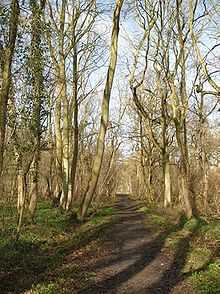Hayley Wood

History
A large wood in this area of the parish was mentioned in the 1068 Domesday Book, but by 1251 it had been split into two: Hayley Wood (40 acres) and Littlehound Wood (32 acres). Agriculture in the area declined after 1350 and the wooded area expanded; by 1650, Hayley Wood covered 120 acres (0.49 km2) and Littlehound 40. Around 1655, Littlehound was 'new stubbed' and disappeared under cultivation, although its outline can still be seen in the form of field boundaries.[1] Hayley Wood was confiscated from the Bishop of Ely by Queen Elizabeth in 1579 and became privately owned.[2]
The Varsity Line - a railway between Bedford and Cambridge - ran along the wood's northern edge between 1863-1969.[2] Now disused, its bed has created different habitats and brought plant species.[3] Hayley Wood was purchased in 1962 by what was then the Cambridgeshire and Isle of Ely Naturalists' Trust[1] (now the Wildlife Trust for Bedfordshire, Cambridgeshire, Northamptonshire and Peterborough).[4]
Geography
Hayley Wood lies in the south-east corner of the civil parish of Little Gransden in Cambridgeshire, 10 miles (17 km) south-west of Cambridge and 45 miles (73 km) north of London.[5] The clay soil is heavy, leading to waterlogged conditions[6] on the flat hilltop.[2]
Flora and fauna
The structure of Hayley Wood is coppice-with-standards of Field Maple, Ash, Hazel and Hawthorn species, with a canopy of Pendunculate Oak and small areas of Small-leaved Elm. Most of the oak trees date from between 1780–1840, older than most woodland oaks.[2]
The soil favours Oxlip[7] and Meadowsweet - the wood is described as 'one of the largest Oxlip woods on the chalky Boulder Clay in Britain'.[6] Bluebell and Yellow Archangel grow in drier parts. Plants typical of ancient woodland, including Wood Anemone, Dog's Mercury and Early Purple Orchid, grow;[2] Bird's-nest Orchid and Pale Sedge can also be found. The wood's plant life is the reason for its designation as a Site of Special Scientific Interest; it was included in Derek Ratcliffe's A Nature Conservation Review,[6] a survey of the country's most important wildlife sites.[8]
Management
There are many ancient coppice stools in the wood; coppicing was practiced from at least the 13th Century until the early 20th Century, with a revival from 1964.[2] Traditional management practices are still used in the woodland, including coppicing of an acre of Hazel per year, and hedgelaying to encourage growth and retain structure. Intervention is kept to a minimum so that the wood can return to its original state[3] and dead wood is left as it is an excellent habitat for liverworts and woodpeckers.[2]
The rides and glades are mown to keep nutrient levels down. Most of the wood is surrounded by a fence, erected in 1972,[2] to exclude deer, which has had the effect of reversing the decline in Hayley Wood's famous Oxlip population.[3]
References
- ↑ 1.0 1.1 'Parishes: Little Gransden', A History of the County of Cambridge and the Isle of Ely: Volume 5 (1973), pp. 87-99. Retrieved 10 April 2009
- ↑ 2.0 2.1 2.2 2.3 2.4 2.5 2.6 2.7 Rackham, O. (1997). The Illustrated History of the Countryside. Second Edition. Phoenix Illustrated, London. pp98-101. ISBN 1-85799-953-3
- ↑ 3.0 3.1 3.2 Wildlife Trust for Bedfordshire, Cambridgeshire, Northamptonshire and Peterborough: Visit a reserve: Hayley Wood. Retrieved 10 April 2009
- ↑ The Wildlife Trust for Bedfordshire, Cambridgeshire, Northamptonshire and Peterborough: History of the Trust. Retrieved 10 April 2009
- ↑ Streetmap.co.uk. Retrieved 10 April 2009
- ↑ 6.0 6.1 6.2 Natural England SSSI citation. Retrieved 10 April 2009
- ↑ http://troglopedetes.blogspot.co.uk/2013/04/hayley-wood.html
- ↑ Peter Marren. Obituary: Derek Ratcliffe. Independent. 26 May 2005. Retrieved 10 April 2009
Coordinates: 52°09′32″N 0°06′54″W / 52.159°N 0.115°W